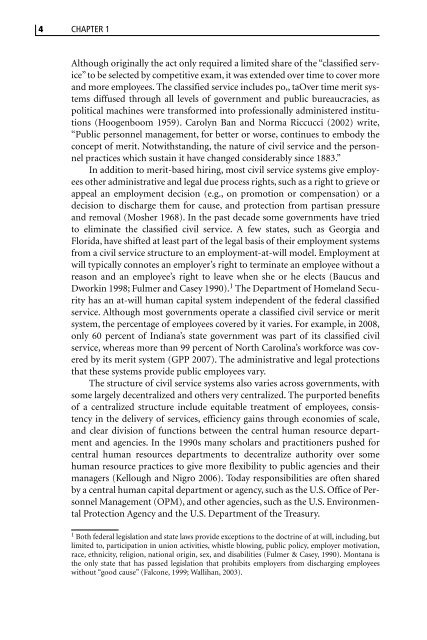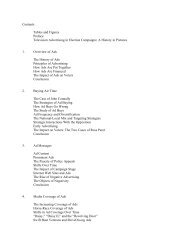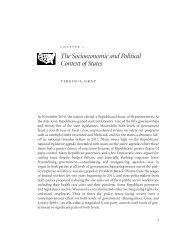Introduction to Human Capital Management in Public ... - CQ Press
Introduction to Human Capital Management in Public ... - CQ Press
Introduction to Human Capital Management in Public ... - CQ Press
You also want an ePaper? Increase the reach of your titles
YUMPU automatically turns print PDFs into web optimized ePapers that Google loves.
010 Selden Ch01 (1-12).qxd 4/29/08 12:59 PM Page 4<br />
4 CHAPTER 1<br />
Although orig<strong>in</strong>ally the act only required a limited share of the “classified service”<br />
<strong>to</strong> be selected by competitive exam, it was extended over time <strong>to</strong> cover more<br />
and more employees. The classified service <strong>in</strong>cludes po,, taOver time merit systems<br />
diffused through all levels of government and public bureaucracies, as<br />
political mach<strong>in</strong>es were transformed <strong>in</strong><strong>to</strong> professionally adm<strong>in</strong>istered <strong>in</strong>stitutions<br />
(Hoogenboom 1959). Carolyn Ban and Norma Riccucci (2002) write,<br />
“<strong>Public</strong> personnel management, for better or worse, cont<strong>in</strong>ues <strong>to</strong> embody the<br />
concept of merit. Notwithstand<strong>in</strong>g, the nature of civil service and the personnel<br />
practices which susta<strong>in</strong> it have changed considerably s<strong>in</strong>ce 1883.”<br />
In addition <strong>to</strong> merit-based hir<strong>in</strong>g, most civil service systems give employees<br />
other adm<strong>in</strong>istrative and legal due process rights, such as a right <strong>to</strong> grieve or<br />
appeal an employment decision (e.g., on promotion or compensation) or a<br />
decision <strong>to</strong> discharge them for cause, and protection from partisan pressure<br />
and removal (Mosher 1968). In the past decade some governments have tried<br />
<strong>to</strong> elim<strong>in</strong>ate the classified civil service. A few states, such as Georgia and<br />
Florida, have shifted at least part of the legal basis of their employment systems<br />
from a civil service structure <strong>to</strong> an employment-at-will model. Employment at<br />
will typically connotes an employer’s right <strong>to</strong> term<strong>in</strong>ate an employee without a<br />
reason and an employee’s right <strong>to</strong> leave when she or he elects (Baucus and<br />
Dwork<strong>in</strong> 1998; Fulmer and Casey 1990). 1 The Department of Homeland Security<br />
has an at-will human capital system <strong>in</strong>dependent of the federal classified<br />
service. Although most governments operate a classified civil service or merit<br />
system, the percentage of employees covered by it varies. For example, <strong>in</strong> 2008,<br />
only 60 percent of Indiana’s state government was part of its classified civil<br />
service, whereas more than 99 percent of North Carol<strong>in</strong>a’s workforce was covered<br />
by its merit system (GPP 2007). The adm<strong>in</strong>istrative and legal protections<br />
that these systems provide public employees vary.<br />
The structure of civil service systems also varies across governments, with<br />
some largely decentralized and others very centralized. The purported benefits<br />
of a centralized structure <strong>in</strong>clude equitable treatment of employees, consistency<br />
<strong>in</strong> the delivery of services, efficiency ga<strong>in</strong>s through economies of scale,<br />
and clear division of functions between the central human resource department<br />
and agencies. In the 1990s many scholars and practitioners pushed for<br />
central human resources departments <strong>to</strong> decentralize authority over some<br />
human resource practices <strong>to</strong> give more flexibility <strong>to</strong> public agencies and their<br />
managers (Kellough and Nigro 2006). Today responsibilities are often shared<br />
by a central human capital department or agency, such as the U.S. Office of Personnel<br />
<strong>Management</strong> (OPM), and other agencies, such as the U.S. Environmental<br />
Protection Agency and the U.S. Department of the Treasury.<br />
1 Both federal legislation and state laws provide exceptions <strong>to</strong> the doctr<strong>in</strong>e of at will, <strong>in</strong>clud<strong>in</strong>g, but<br />
limited <strong>to</strong>, participation <strong>in</strong> union activities, whistle blow<strong>in</strong>g, public policy, employer motivation,<br />
race, ethnicity, religion, national orig<strong>in</strong>, sex, and disabilities (Fulmer & Casey, 1990). Montana is<br />
the only state that has passed legislation that prohibits employers from discharg<strong>in</strong>g employees<br />
without “good cause” (Falcone, 1999; Wallihan, 2003).









